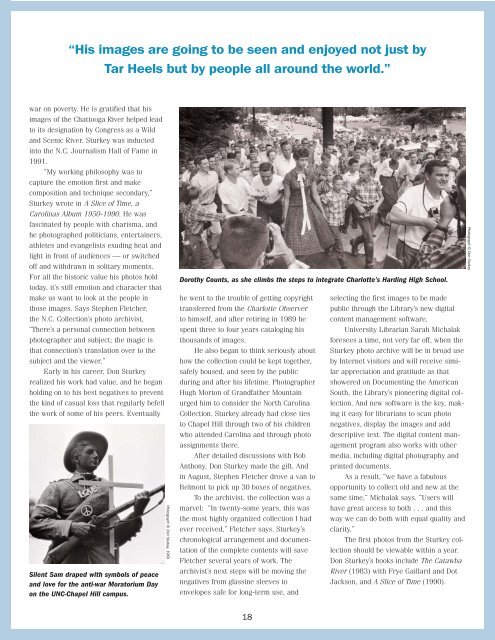Windows Newsletter 10-05.qxd - University of North Carolina at ...
Windows Newsletter 10-05.qxd - University of North Carolina at ...
Windows Newsletter 10-05.qxd - University of North Carolina at ...
Create successful ePaper yourself
Turn your PDF publications into a flip-book with our unique Google optimized e-Paper software.
“His images are going to be seen and enjoyed not just by<br />
Tar Heels but by people all around the world.”<br />
war on poverty. He is gr<strong>at</strong>ified th<strong>at</strong> his<br />
images <strong>of</strong> the Ch<strong>at</strong>tooga River helped lead<br />
to its design<strong>at</strong>ion by Congress as a Wild<br />
and Scenic River. Sturkey was inducted<br />
into the N.C. Journalism Hall <strong>of</strong> Fame in<br />
1991.<br />
“My working philosophy was to<br />
capture the emotion first and make<br />
composition and technique secondary,”<br />
Sturkey wrote in A Slice <strong>of</strong> Time, a<br />
<strong>Carolina</strong>s Album 1950-1990. He was<br />
fascin<strong>at</strong>ed by people with charisma, and<br />
he photographed politicians, entertainers,<br />
<strong>at</strong>hletes and evangelists exuding he<strong>at</strong> and<br />
light in front <strong>of</strong> audiences — or switched<br />
<strong>of</strong>f and withdrawn in solitary moments.<br />
For all the historic value his photos hold<br />
today, it’s still emotion and character th<strong>at</strong><br />
make us want to look <strong>at</strong> the people in<br />
those images. Says Stephen Fletcher,<br />
the N.C. Collection’s photo archivist,<br />
“There’s a personal connection between<br />
photographer and subject; the magic is<br />
th<strong>at</strong> connection’s transl<strong>at</strong>ion over to the<br />
subject and the viewer.”<br />
Early in his career, Don Sturkey<br />
realized his work had value, and he began<br />
holding on to his best neg<strong>at</strong>ives to prevent<br />
the kind <strong>of</strong> casual loss th<strong>at</strong> regularly befell<br />
the work <strong>of</strong> some <strong>of</strong> his peers. Eventually<br />
Silent Sam draped with symbols <strong>of</strong> peace<br />
and love for the anti-war Mor<strong>at</strong>orium Day<br />
on the UNC-Chapel Hill campus.<br />
Photograph © Don Sturkey, 1969<br />
Dorothy Counts, as she climbs the steps to integr<strong>at</strong>e Charlotte’s Harding High School.<br />
he went to the trouble <strong>of</strong> getting copyright<br />
transferred from the Charlotte Observer<br />
to himself, and after retiring in 1989 he<br />
spent three to four years c<strong>at</strong>aloging his<br />
thousands <strong>of</strong> images.<br />
He also began to think seriously about<br />
how the collection could be kept together,<br />
safely housed, and seen by the public<br />
during and after his lifetime. Photographer<br />
Hugh Morton <strong>of</strong> Grandf<strong>at</strong>her Mountain<br />
urged him to consider the <strong>North</strong> <strong>Carolina</strong><br />
Collection. Sturkey already had close ties<br />
to Chapel Hill through two <strong>of</strong> his children<br />
who <strong>at</strong>tended <strong>Carolina</strong> and through photo<br />
assignments there.<br />
After detailed discussions with Bob<br />
Anthony, Don Sturkey made the gift. And<br />
in August, Stephen Fletcher drove a van to<br />
Belmont to pick up 30 boxes <strong>of</strong> neg<strong>at</strong>ives.<br />
To the archivist, the collection was a<br />
marvel: “In twenty-some years, this was<br />
the most highly organized collection I had<br />
ever received,” Fletcher says. Sturkey’s<br />
chronological arrangement and document<strong>at</strong>ion<br />
<strong>of</strong> the complete contents will save<br />
Fletcher several years <strong>of</strong> work. The<br />
archivist’s next steps will be moving the<br />
neg<strong>at</strong>ives from glassine sleeves to<br />
envelopes safe for long-term use, and<br />
18<br />
selecting the first images to be made<br />
public through the Library’s new digital<br />
content management s<strong>of</strong>tware.<br />
<strong>University</strong> Librarian Sarah Michalak<br />
foresees a time, not very far <strong>of</strong>f, when the<br />
Sturkey photo archive will be in broad use<br />
by Internet visitors and will receive similar<br />
appreci<strong>at</strong>ion and gr<strong>at</strong>itude as th<strong>at</strong><br />
showered on Documenting the American<br />
South, the Library’s pioneering digital collection.<br />
And new s<strong>of</strong>tware is the key, making<br />
it easy for librarians to scan photo<br />
neg<strong>at</strong>ives, display the images and add<br />
descriptive text. The digital content management<br />
program also works with other<br />
media, including digital photography and<br />
printed documents.<br />
As a result, “we have a fabulous<br />
opportunity to collect old and new <strong>at</strong> the<br />
same time,” Michalak says. “Users will<br />
have gre<strong>at</strong> access to both . . . and this<br />
way we can do both with equal quality and<br />
clarity.”<br />
The first photos from the Sturkey collection<br />
should be viewable within a year.<br />
Don Sturkey’s books include The C<strong>at</strong>awba<br />
River (1983) with Frye Gaillard and Dot<br />
Jackson, and A Slice <strong>of</strong> Time (1990).<br />
Photograph © Don Sturkey



